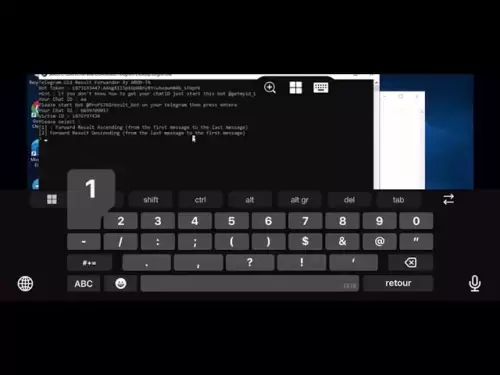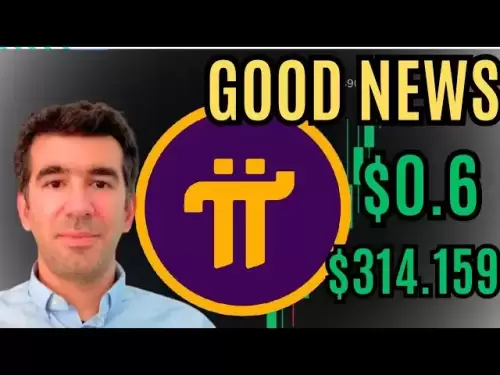-
 Bitcoin
Bitcoin $107,337.4054
-1.63% -
 Ethereum
Ethereum $2,647.1005
-0.75% -
 Tether USDt
Tether USDt $1.0001
-0.02% -
 XRP
XRP $2.2590
-2.59% -
 BNB
BNB $686.9810
-0.28% -
 Solana
Solana $171.1956
-3.20% -
 USDC
USDC $0.9998
0.01% -
 Dogecoin
Dogecoin $0.2196
-3.19% -
 Cardano
Cardano $0.7418
-2.57% -
 TRON
TRON $0.2738
-1.17% -
 Sui
Sui $3.5695
-2.95% -
 Hyperliquid
Hyperliquid $33.6011
-6.91% -
 Chainlink
Chainlink $15.5183
-2.55% -
 Avalanche
Avalanche $23.2215
-0.59% -
 Stellar
Stellar $0.2826
-1.89% -
 UNUS SED LEO
UNUS SED LEO $9.0794
-0.02% -
 Shiba Inu
Shiba Inu $0.0...01415
-2.19% -
 Toncoin
Toncoin $3.3190
10.19% -
 Bitcoin Cash
Bitcoin Cash $411.4902
-1.16% -
 Hedera
Hedera $0.1837
-2.82% -
 Litecoin
Litecoin $95.0625
-0.99% -
 Polkadot
Polkadot $4.5044
-0.94% -
 Monero
Monero $342.4378
-9.41% -
 Bitget Token
Bitget Token $5.2289
-2.25% -
 Pepe
Pepe $0.0...01381
-0.72% -
 Dai
Dai $0.9997
-0.02% -
 Pi
Pi $0.7272
-3.28% -
 Ethena USDe
Ethena USDe $1.0008
0.01% -
 Uniswap
Uniswap $6.6847
3.36% -
 Aave
Aave $262.1465
-4.38%
Should I stop loss if SAR is continuously above the K-line?
When SAR remains above the K-line, indicating a downtrend, consider using a stop loss to manage risk, but be aware of potential whipsawing and false signals.
May 27, 2025 at 10:50 am
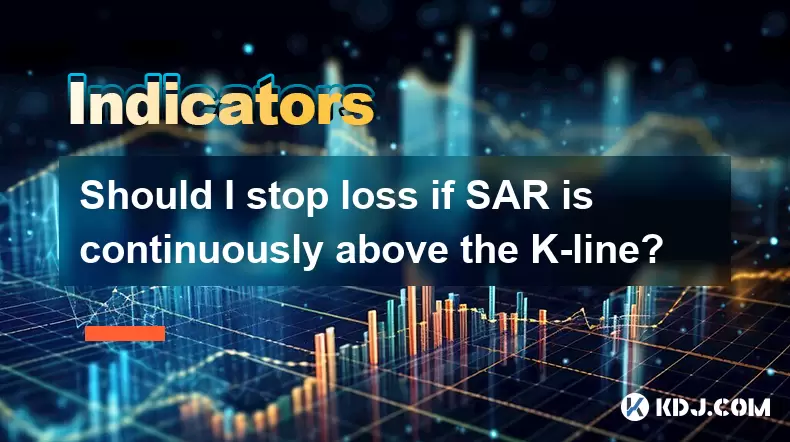
When navigating the volatile waters of cryptocurrency trading, one of the pivotal questions traders often face is whether to implement a stop loss when the Parabolic SAR (SAR) indicator remains consistently above the price candlestick, or K-line. This article delves into the intricacies of using the Parabolic SAR in conjunction with stop loss strategies to help traders make informed decisions.
Understanding the Parabolic SAR Indicator
The Parabolic SAR, or Stop and Reverse, is a popular technical analysis tool used by traders to determine the direction of an asset's momentum and potential reversal points. When the SAR dots appear below the price, it suggests an uptrend, and when they are above the price, it indicates a downtrend. The key to using this indicator effectively lies in understanding its signals and integrating them with other aspects of your trading strategy.
The Role of Stop Loss in Trading
A stop loss order is a critical risk management tool that traders use to limit potential losses on a position. By setting a stop loss, traders can automatically exit a trade if the price moves against them beyond a predetermined level. This mechanism is essential in the unpredictable cryptocurrency market, where sudden price swings can lead to significant losses.
Analyzing the Scenario: SAR Continuously Above the K-line
When the SAR remains continuously above the K-line, it signals that the asset is in a sustained downtrend. This scenario suggests that the bearish momentum is strong and that the price may continue to fall. For traders, this presents a critical decision point: whether to hold onto a losing position in hopes of a reversal or to cut losses by implementing a stop loss.
Should You Use a Stop Loss in This Situation?
The decision to use a stop loss when the SAR is continuously above the K-line depends on several factors, including your risk tolerance, trading strategy, and the specific asset's behavior. Here are some considerations:
Risk Management: If you have a low risk tolerance, using a stop loss can help protect your capital from further declines. Setting a stop loss at a level that aligns with your risk management plan can prevent a small loss from turning into a significant one.
Trading Strategy: Depending on your strategy, you might choose to hold onto the position if you believe in a potential reversal based on other indicators or fundamental analysis. However, if your strategy emphasizes quick exits from losing trades, a stop loss becomes a crucial tool.
Asset Volatility: Cryptocurrencies are known for their high volatility. In such a market, a stop loss can be particularly useful to manage the rapid price movements that can occur.
How to Set a Stop Loss When SAR is Above the K-line
If you decide to use a stop loss when the SAR is continuously above the K-line, here's how you can set it up:
Identify the Current Price and SAR Level: First, note the current price of the asset and the level at which the SAR dots are positioned above the K-line.
Determine Your Stop Loss Level: Decide on the level at which you want the stop loss to trigger. This could be a percentage below the current price or a specific price point that aligns with your risk management strategy.
Set the Stop Loss Order: Use your trading platform to place a stop loss order at the chosen level. Here’s how you might do it:
- Open your trading platform.
- Navigate to the asset you are trading.
- Select the open position or the asset you wish to trade.
- Choose the option to set a stop loss.
- Enter the stop loss price and confirm the order.
Monitor and Adjust: Keep an eye on the market and be prepared to adjust your stop loss if the asset's price continues to move in your favor or if market conditions change.
Potential Pitfalls of Using a Stop Loss with SAR
While using a stop loss can be beneficial, there are potential pitfalls to consider:
Whipsawing: In highly volatile markets, prices can fluctuate rapidly, causing the stop loss to be triggered even if the overall trend remains intact. This can lead to unnecessary exits from potentially profitable trades.
Gaps: Cryptocurrency markets can experience gaps where the price jumps from one level to another without trading in between. If the price gaps below your stop loss level, you might exit the trade at a worse price than intended.
False Signals: The SAR indicator, like any other technical tool, can produce false signals. If the SAR remains above the K-line but the price soon reverses, a stop loss triggered during this period could lead to a missed opportunity.
Balancing SAR and Stop Loss in Your Trading Plan
Integrating the Parabolic SAR with a stop loss strategy requires a balanced approach. Here’s how you can do it effectively:
Combine with Other Indicators: Use the SAR in conjunction with other technical indicators, such as moving averages or the Relative Strength Index (RSI), to confirm trends and potential reversals. This can help reduce the likelihood of acting on false signals.
Backtest Your Strategy: Before applying the SAR and stop loss combination in live trading, backtest your strategy using historical data. This can help you understand how well the strategy might perform in different market conditions.
Stay Flexible: Be prepared to adapt your strategy based on market conditions. If the market becomes more volatile or if the asset’s behavior changes, you might need to adjust your stop loss levels or reconsider using a stop loss altogether.
Frequently Asked Questions
Q: Can I use the Parabolic SAR for entry signals as well as exit signals?
A: Yes, the Parabolic SAR can be used for both entry and exit signals. When the SAR dots flip from above to below the price, it can signal a potential entry point for a long position. Conversely, when the dots move from below to above the price, it might indicate a good time to exit a long position or enter a short position.
Q: How often should I adjust my stop loss when using the SAR indicator?
A: The frequency of adjusting your stop loss depends on your trading strategy and the asset's volatility. Some traders adjust their stop loss daily or even intraday to lock in profits or reduce risk, while others might set it and leave it unless significant market changes occur.
Q: Is it possible to use a trailing stop loss with the Parabolic SAR?
A: Yes, a trailing stop loss can be used effectively with the Parabolic SAR. As the SAR dots move closer to the price during an uptrend, you can adjust your trailing stop loss to follow the SAR, helping you capture more profits while still protecting against reversals.
Q: What should I do if the SAR remains above the K-line but the price starts to recover?
A: If the price begins to recover while the SAR is still above the K-line, it might be a sign of a potential reversal. Monitor other indicators and market conditions. If the recovery seems strong and supported by other signals, you might choose to hold your position or adjust your stop loss to give the trade more room to breathe.
Disclaimer:info@kdj.com
The information provided is not trading advice. kdj.com does not assume any responsibility for any investments made based on the information provided in this article. Cryptocurrencies are highly volatile and it is highly recommended that you invest with caution after thorough research!
If you believe that the content used on this website infringes your copyright, please contact us immediately (info@kdj.com) and we will delete it promptly.
- Bitcoin (BTC) Price Recovers 2.6% from May 23rd's Low of $107,278, Ethereum (ETH) Is Up 3.6%
- 2025-05-29 06:45:14
- SEC v. Ripple: Focus turns to closed-door meeting as court deadline looms
- 2025-05-29 06:45:14
- Ethereum price surge highlights positive momentum. Meanwhile, a new AI-powered coin, Unilabs, enters the spotlight with more real-world utility than Dogecoin.
- 2025-05-29 06:40:13
- Ruble-Pegged Stablecoin A7A5 Takes a Defining Step Toward Becoming a Regional Hub for Digital Assets
- 2025-05-29 06:40:13
- TRIBE DEX Brings Real DeFi Utility to Life with TMX TGE: Only 485 ETH Available After $871K Raised
- 2025-05-29 06:35:14
- Pepe Coin: The Hype Is Loud but the Growth May Be Slowing
- 2025-05-29 06:35:14
Related knowledge
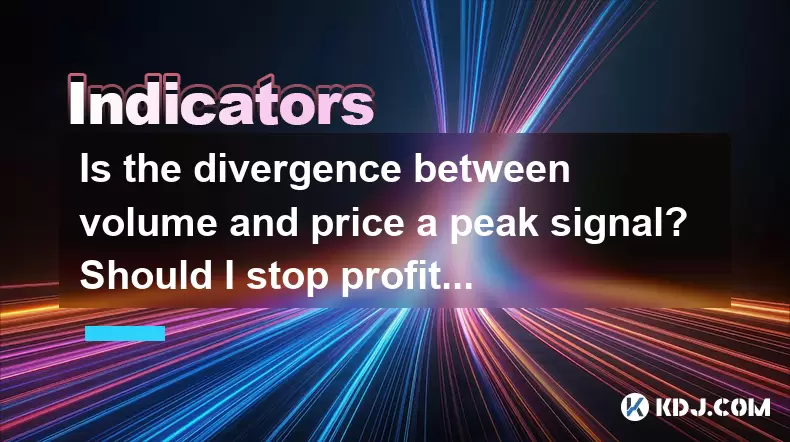
Is the divergence between volume and price a peak signal? Should I stop profit or hold?
May 29,2025 at 04:43am
Is the divergence between volume and price a peak signal? Should I stop profit or hold? In the world of cryptocurrencies, traders often look for signals that can indicate potential peaks or troughs in market trends. One such signal that traders frequently monitor is the divergence between volume and price. This phenomenon occurs when the trading volume ...
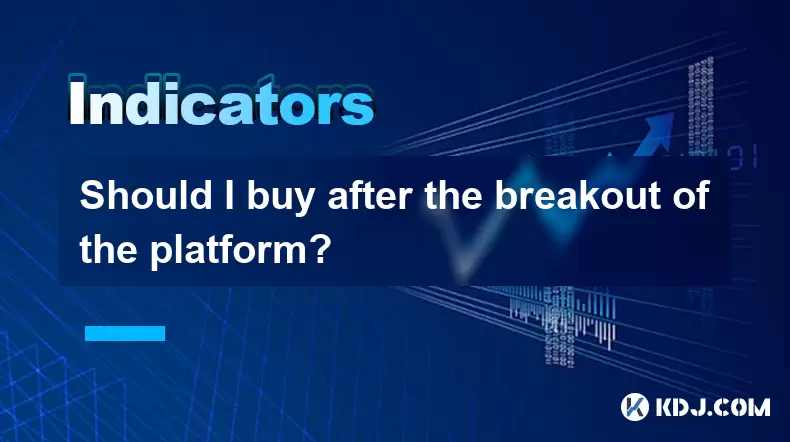
Should I buy after the breakout of the platform?
May 29,2025 at 04:35am
Understanding Breakouts in CryptocurrencyBreakouts in the cryptocurrency market occur when the price of a digital asset moves above a defined resistance level or below a support level, often leading to increased volatility and trading activity. A breakout can signal the start of a new trend, either bullish or bearish, depending on the direction of the p...
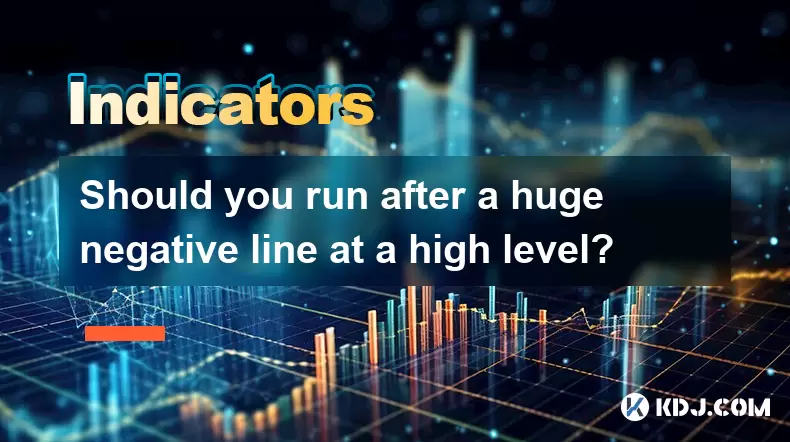
Should you run after a huge negative line at a high level?
May 29,2025 at 04:21am
Should you run after a huge negative line at a high level? When navigating the volatile world of cryptocurrencies, one of the most challenging decisions traders face is whether to chase a significant price drop after a high. A huge negative line at a high level often signals a sharp reversal in market sentiment, and understanding how to react to such mo...
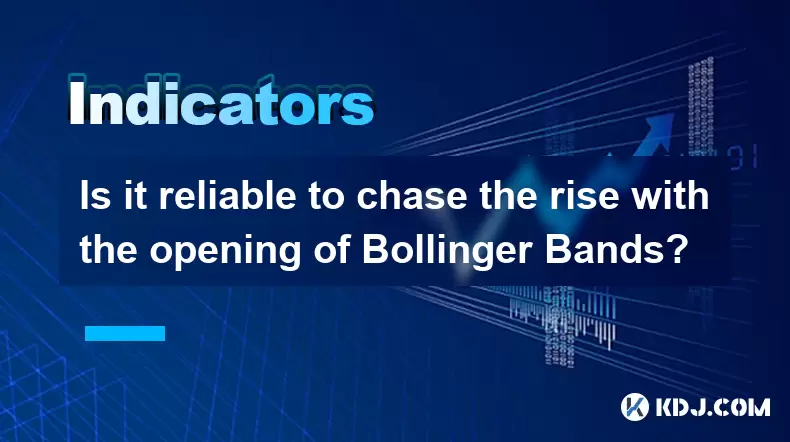
Is it reliable to chase the rise with the opening of Bollinger Bands?
May 29,2025 at 06:21am
Introduction to Bollinger BandsBollinger Bands are a technical analysis tool developed by John Bollinger. They consist of a middle band being a simple moving average (SMA) and two outer bands that are standard deviations away from the middle band. The standard setting for Bollinger Bands is a 20-day SMA with the outer bands set two standard deviations a...
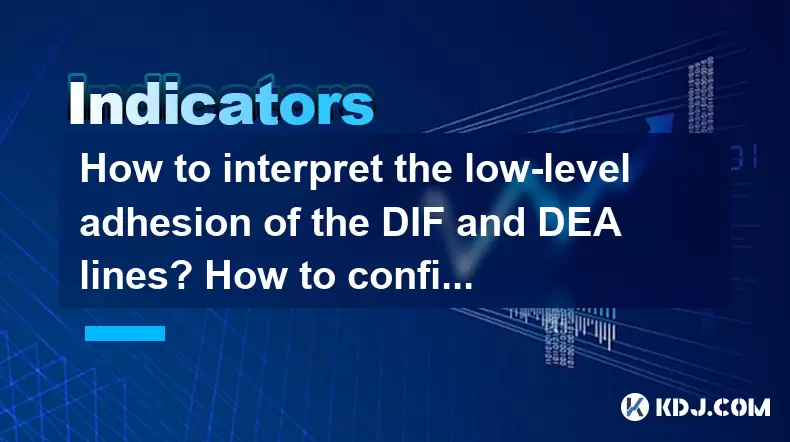
How to interpret the low-level adhesion of the DIF and DEA lines? How to confirm the direction selection signal?
May 29,2025 at 02:49am
Understanding the low-level adhesion of the DIF and DEA lines in the context of cryptocurrency trading involves delving into the specifics of the Moving Average Convergence Divergence (MACD) indicator. The MACD is a trend-following momentum indicator that shows the relationship between two moving averages of a cryptocurrency's price. The DIF line, also ...
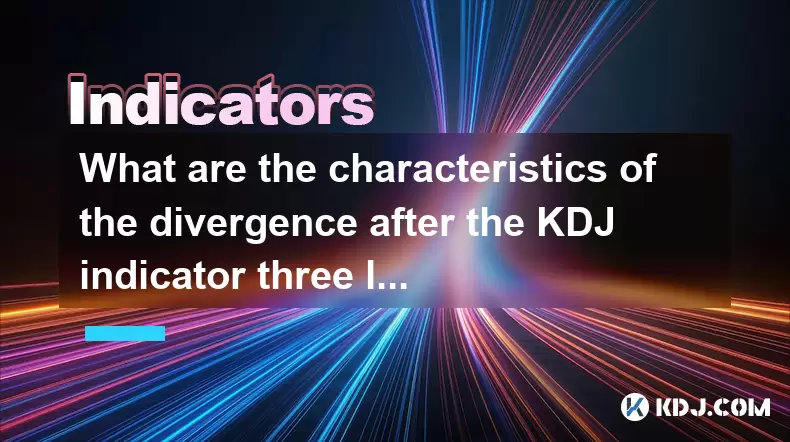
What are the characteristics of the divergence after the KDJ indicator three lines merge into one? What are the direction selection signals?
May 29,2025 at 03:14am
The KDJ indicator is a popular tool used in the cryptocurrency trading community to identify potential trend reversals and to gauge the momentum of price movements. When the three lines of the KDJ indicator—namely the K line, D line, and J line—merge into one, it often signifies a significant event in the market. This phenomenon is known as a divergence...

Is the divergence between volume and price a peak signal? Should I stop profit or hold?
May 29,2025 at 04:43am
Is the divergence between volume and price a peak signal? Should I stop profit or hold? In the world of cryptocurrencies, traders often look for signals that can indicate potential peaks or troughs in market trends. One such signal that traders frequently monitor is the divergence between volume and price. This phenomenon occurs when the trading volume ...

Should I buy after the breakout of the platform?
May 29,2025 at 04:35am
Understanding Breakouts in CryptocurrencyBreakouts in the cryptocurrency market occur when the price of a digital asset moves above a defined resistance level or below a support level, often leading to increased volatility and trading activity. A breakout can signal the start of a new trend, either bullish or bearish, depending on the direction of the p...

Should you run after a huge negative line at a high level?
May 29,2025 at 04:21am
Should you run after a huge negative line at a high level? When navigating the volatile world of cryptocurrencies, one of the most challenging decisions traders face is whether to chase a significant price drop after a high. A huge negative line at a high level often signals a sharp reversal in market sentiment, and understanding how to react to such mo...

Is it reliable to chase the rise with the opening of Bollinger Bands?
May 29,2025 at 06:21am
Introduction to Bollinger BandsBollinger Bands are a technical analysis tool developed by John Bollinger. They consist of a middle band being a simple moving average (SMA) and two outer bands that are standard deviations away from the middle band. The standard setting for Bollinger Bands is a 20-day SMA with the outer bands set two standard deviations a...

How to interpret the low-level adhesion of the DIF and DEA lines? How to confirm the direction selection signal?
May 29,2025 at 02:49am
Understanding the low-level adhesion of the DIF and DEA lines in the context of cryptocurrency trading involves delving into the specifics of the Moving Average Convergence Divergence (MACD) indicator. The MACD is a trend-following momentum indicator that shows the relationship between two moving averages of a cryptocurrency's price. The DIF line, also ...

What are the characteristics of the divergence after the KDJ indicator three lines merge into one? What are the direction selection signals?
May 29,2025 at 03:14am
The KDJ indicator is a popular tool used in the cryptocurrency trading community to identify potential trend reversals and to gauge the momentum of price movements. When the three lines of the KDJ indicator—namely the K line, D line, and J line—merge into one, it often signifies a significant event in the market. This phenomenon is known as a divergence...
See all articles





















